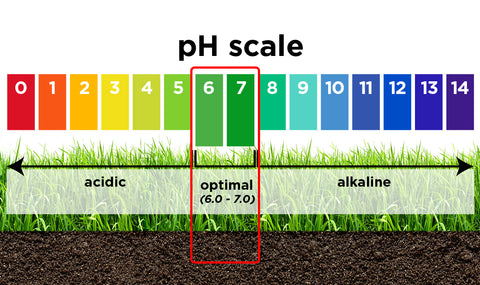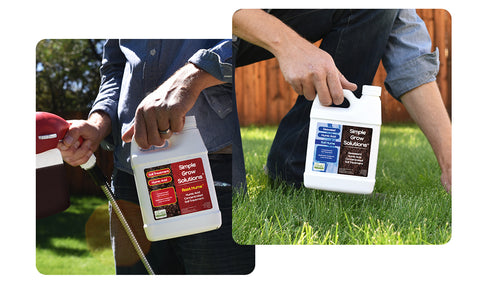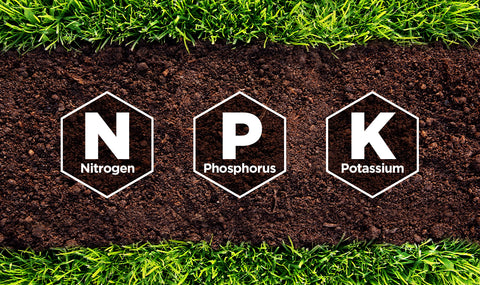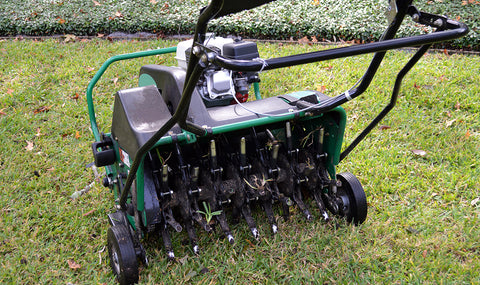Discovering the potential of your lawn begins with understanding the importance of a soil test—an essential step in unlocking the secrets to healthier, more vibrant turfgrass. Once soil test results are returned and the recommendations are reviewed, the next step involves addressing the soil pH, which is a key determining factor for correcting acidic or alkaline soil.
This is a good starting point because a low or high pH can cause necessary nutrients to be “locked up” in the soil and unavailable to the turfgrass. Low or high pH symptoms can appear as a nutrient deficiency when adequate nutrients are within the soil. Improving the pH to 6.0 - 7.0 will be required to release nutrients locked within the soil and not absorbed by the roots or leaf tissue.
Managing Soil pH in Acidic Soils
When soil tests below 7.0 it indicates increasing soil acidity, with the ideal range for optimal turfgrass growth falling between 6.0 and 7.0. There are a couple turfgrass varieties with exceptions, such as centipede and paspalum, which thrive better in a slightly acidic to acidic soil pH.
Managing these two turfs is exceptional because the pH can be 6.0 - 7.0, but it would produce a more optimal root zone if the soil were below 6.0.

This is one of the few times in turfgrass management when a plant would benefit from supplementing sulfuric acid to increase acidity and lower pH. The same is true when working with soil for landscape plants and shrubs. The lawn can thrive due to the optimal pH range, but the azalea shrubs are not reaching their fullest growth potential because they grow best in more acidic soil.
Raising the pH cannot be done significantly with one application of limestone. Managing acidity in the soil becomes a continual maintenance practice, so soils continue to improve throughout growing seasons. Soil amendments are required so nutrients become available to the grass plants, which enhances the appearance and reaction to accepting additional nutrients in the future.

Managing Soil pH in Alkaline Soils
Soil test results with a pH above 7.0 will require a sulfuric acid or sulfur-based product labeled to decrease alkalinity in the soil. If the soil has a high pH, it doesn't allow nutrients like iron to dissolve quickly; thus, the plants cannot get enough nutrients through their roots. Weak stems on plants are a common symptom when the soil is alkaline, as the plants cannot take the necessary nutrients from the soil. Soil alkalinity indicates a higher calcium carbonate content, producing chalky, highly porous soil. Plants in alkaline soils often grow curled, yellow leaves and purple stems.
The same principle remains the same for lowering pH as it does for raising pH; it becomes an essential part of the overall maintenance plan season after season. Multiple applications of soil amendments are required to lower the alkalinity for better optimal growing conditions within the soil. Alkaline soils can be neutralized with elemental sulfur, iron sulfate, or aluminum sulfate. A significant problem in alkaline soils is the reduced availability of nutrients, particularly micronutrients.
These types of soils are commonly found in the western United States, where limited rainfall makes it less likely for acidic components to be washed through the soil. If sulfuric acid or sulfur is needed to lower the pH, the soil test report will provide specific instructions on the amount of material to add per 1,000 square feet.

Increasing Micronutrient Presence Within the Soil
Root zone elements such as micronutrients must align in the proper pattern or number for turfgrass to grow. Excessive levels of one element can disrupt the availability of other essential nutrients. Detailed soil tests will display deficiencies in micronutrients within the root zone profile, where boron, zinc, manganese, iron, copper, molybdenum, and chlorine are among the seven essential micronutrients for plant life.
The most significant merit of seaweed is its organic matter that breaks down quickly in soil. Applying Lawn Energizer or Micro Booster will supply essential micronutrients, aid in correcting micro deficiencies, and promote a vigorous turfgrass. Seaweed and Humic acid can also improve the uptake of micronutrients.

After using these products, it's advisable to return grass clippings to the surface. This allows the organic decomposition process to reintroduce micronutrients from the leaf blade tissues back into the soil, enabling continuous absorption by the plant. Adding organic compost is another great way to keep your soil rich with the micronutrients it needs long-term.
Increasing Macronutrient Presence Within the Soil
Nitrogen, phosphorus, and potassium are needed in more significant amounts compared to other nutrients like sulfur, calcium, and magnesium, while micronutrients such as iron and copper are essential in smaller amounts.
Soil tests that show low nitrogen levels will state the correct amount of nitrogen needed to accomplish optimal levels. If phosphorus and potassium levels are below optimal, similar recommendations will be provided via the soil test regarding the amount of NPK required to correct deficiencies.

Increasing Soil’s Cation Exchange Capacity (CEC)
The cation exchange capacity (CEC) of soil determines its ability to hold and exchange cations. The three main factors influencing this capacity are the soil's clay content, organic matter content, and pH level. Soils with a low CEC are more likely to develop potassium and magnesium deficiencies, while high CEC soils are less susceptible to leaching these cations.
Soil modification uses various soil amendments, increased fertilizer applications, or both. These soils are typically high in sand and silt and suffer from a deficiency in organic matter. Incorporating clean organic matter will benefit the overall condition of lawns and increase the CEC to higher levels so essential nutrients can be held in the soil for a more extended period.
Soil Organic Matter (OM)
The ideal soil organic matter level ranges from 5% to 8%. Increasing organic matter in soil can be achieved by incorporating organic materials such as compost, decomposed leaves, and grass clippings, which can improve nutrient-holding capacity. It's advisable to increase the amount of organic matter content only when the overall percentage falls below 5%.
Excessive organic matter in soils results in low soil oxygen, shallow rooting, high soil moisture level, decreased internal drainage, and disease or pest activity. To reduce the levels of organic material in root zones, core aeration, deep tine aeration, dethatching, and topdressing introduce microbes that eat organic matter. Once oxygen enters through an aeration opening, organic matter starts to decay, while dethatching removes dead tissues and organic matter.
Performing core aeration and dethatching in coordination with topdressing and soil amendments in soils with excessive amounts of organic matter will significantly improve the overall health of the grass.

An Overview of Soil Testing
Soil testing comprises four steps: sampling, analysis, interpretation, and recommendation. Interpretation is simply characterizing soil pH and nutrient levels by keywords like low, medium, optimal, high, and excessive. Relying on test results for incorporating corrective actions and materials for optimal growing conditions is based on scientific data that was taken from the original samples and dictated a clear plan of action to improve lawns and landscapes. Many elements within the soil must align and react to each other to produce the ideal growing conditions for lawns. Soil testing is recommended to be performed every two to three years. Still, to confirm the recommended corrective actions and added materials are working, a soil test should be performed each growing season.









